“Drew, what in the world is an award efficiency rating, and how does British Airways Avios have one? Did you just make this up?”
Yes, I did. But get used to it! Because I’m going to be doing posts with efficiency ratings more often!
And not just British Airways Avios, but for many programs. In fact, I got the idea working on an upcoming JAL post.
So this post is really just to introduce the concept of an “award efficiency rating”.
Let me explain what it is, and what cool things you can discover from it (using Avios)…
What Is An Award Efficiency Rating?
For a distance based award chart, it is simply taking the maximum distance in a tier and dividing by the rewards price to get a number I’m calling an efficiency rating.
For example, a partner flying up to 2,000 flown miles would cost you 11,000 BA Avios to redeem for that flight. 11,000 divided by 2,000 is 5.5, and 5.5 is the cost per flown mile.
For most distance based award charts, the cost per mile goes down the more you fly… but not with BA Avios.
Using Stopovers To Save Avios
In early 2013 I started a series on “Using Stopovers To Save Avios” and the concept was to find the most efficient range for redeeming miles and showing how that could save Avios.
While a number of the examples have been gutted out by the Avios devaluations, a modern example might look like this (in economy):
- Miami to Santiago, Chile = 25,750 Avios
Yet…
- Miami to Bogota, Colombia = 11,000 Avios
- Bogota to Santiago = 13,000
That’s a total of 24,000 Avios (instead of 25,750) to add another (awesome) country on your trip, a stop that could be as long as you want!
The key to this is knowing the Avios efficiency rating.
BA Avios Efficiency Rating by Award Chart
Earlier I wrote a post explaining the difference between the 5 BA Avios Award Charts. If you’re unfamiliar, check out that post.
The short version is that while most distance based award charts add up the total distance flown to get the price, most of the BA Avios award charts are priced per segment. That is, get the distance for each segment, get the price, then add up all the prices.
They have one traditional distance based chart when you fly on more than one partner… However, it’s easy to just book your segments separately with BA and use whatever award chart you want.
Therefore, the efficiency rating can not only be used to figure out what distances to break your trip into, but what award chart to use.
These ratings are based on the furthest distance in a range and divided by the price.
BA Avios: Partner Award Chart Efficiency Rating
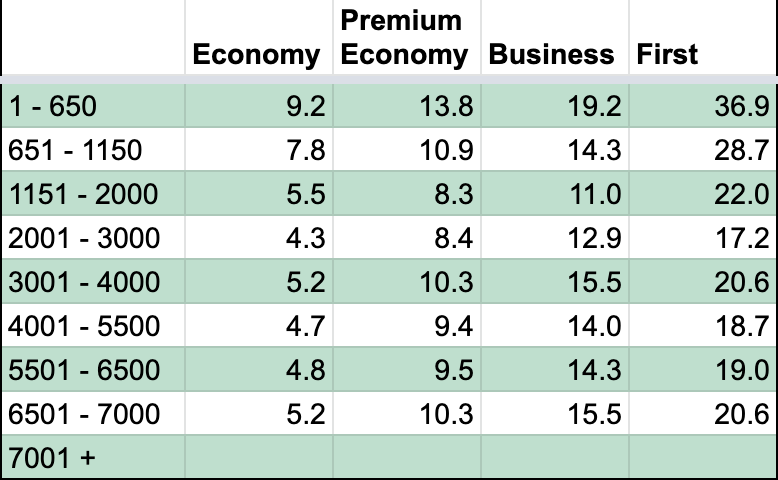
Note that this is for all non-Avios partners, except the next award chart is modified to represent the changes for AA and Alaska flights, as BA wanted to decrease the value for flights departing or within the US.
BA Avios: AA & Alaska Award Chart Efficiency Rating
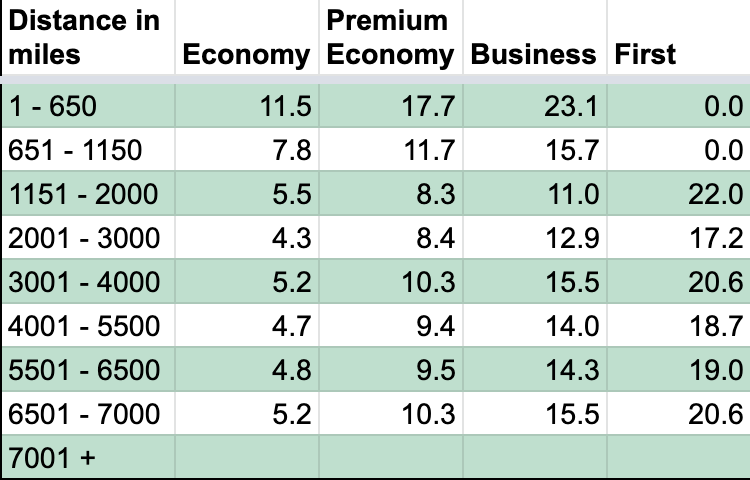
BA Avios: BA & Aer Lingus Award Chart Efficiency Rating
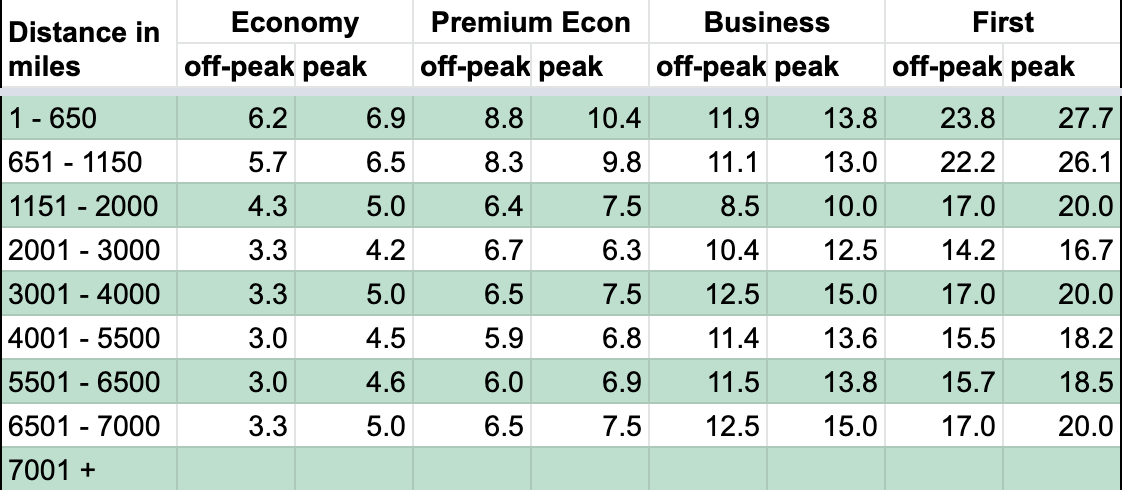
BA Avios: Iberia Award Chart Efficiency Rating
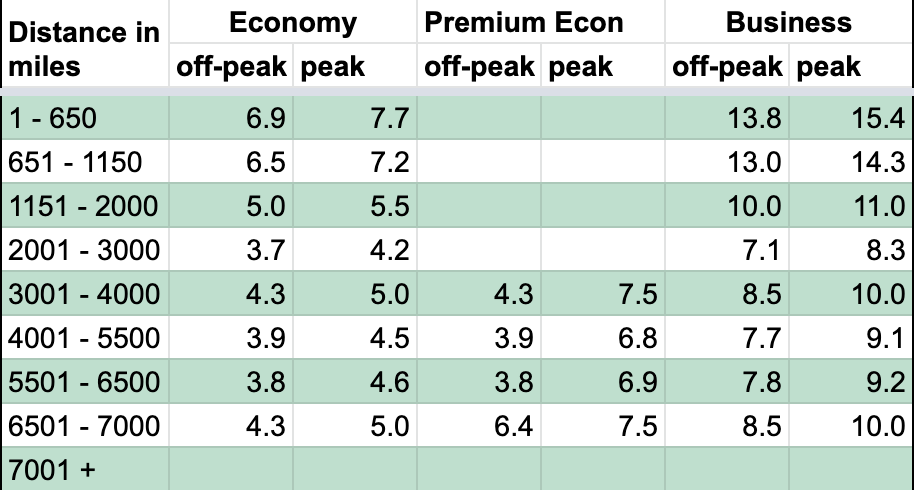
BA Avios: Multi-Carrier Award Chart Efficiency Rating
(This is the chart that uses total distance flown)
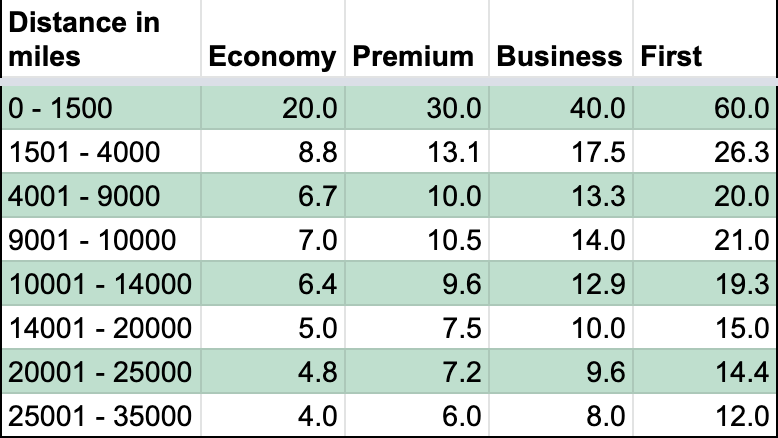
Summary
Reminder: These are not award charts, but you can find all awards in the recent post on –> BA Avios Award Charts.
These are ratings to find the most efficient price range.
The Most Efficient Ranges
In every category, the most efficient ranges are the BA and Aer Lingus award chart. However, as you may already know, BA flights tack on huge fuel surcharges. This alone makes redeeming Avios for BA a complete no go.
And while the Avios award chart for BA flights has 3.0 ratings on it, they are all off-peak. Thus, users may not be able to redeem at that better rate the majority of the time, by definition.
Even Iberia off-peak is one of the best non-BA prices, but has $200+ in fuel surcharges for a oneway to Europe in economy, and $600+ for business class!
Therefore, sticking to AA / Partners, the best range is staying as close to 3,000 miles as possible without going over.
The only time this isn’t true is business class, which is cheaper, 2,000 and under… But how often do I need a short business class flight?
Since business class is mostly used for long flights, this is where the Multi-Carrier award chart overtakes the AA / Partner award chart in value.
For super long range flights, business class gets down to an efficiency rating of 8.0 and first class gets down to 12.0 (which are better than even BA’s off-peaks).
In economy, you could get better value, but only at the top range of flying over 25,000 miles… which is a really long ticket.
Simply put, if you’re not booking an extremely long distance roundtrip ticket, it is certainly cheaper to use the first partner and AA award charts for economy.
And the best range of all is 3,000 miles or slightly under.
Being close to, but under, 3,000 flown miles is what made the original stopover example – stopping in Bogota on the way to Chile – cheaper than a direct.
- The BOG to SCL leg is 2,629 flown miles and costs 13,000 Avios
- That’s a value of 4.95 per mile
- MIA direct to SCL is 4,118 flown miles and costs 25,750
- That’s a value of 6.25 per mile
The cost per mile (aka, the “efficiency rating”) is so much higher in the 2,001 to 3,000 flown mile range, that it makes the total cost of ticket cheaper than the direct flight.
Remember, the efficiency rating is based on the maximum miles in the range.
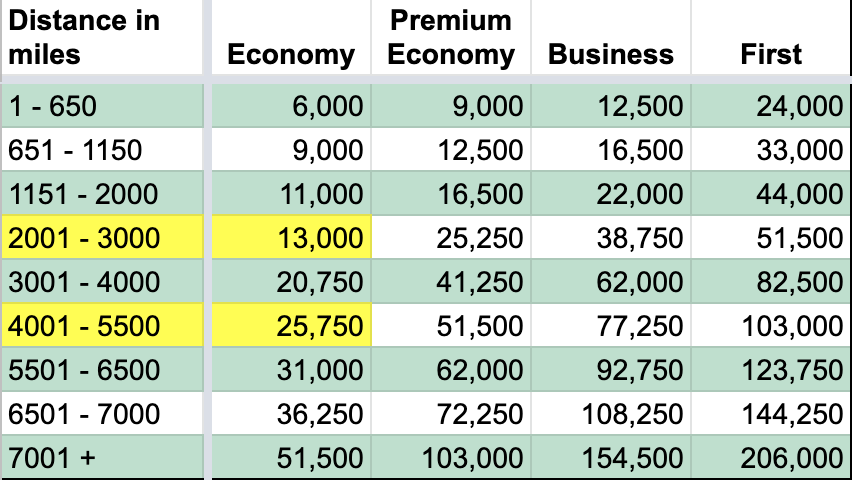
The range of 2,001 to 3,000 flown miles is the best range based on the best possible outcome. Meaning, the price in economy is the same 13,000 Avios regardless of if you flew 2,003 miles or 2,999 miles. So if you’re going to pay for the range, you get the most value out of a flight that’s as close to 3,000 as possible.
Therefore, the efficiency rating is the price (13,000 Avios) divided by the top of the range (3,000), and the result is the below.
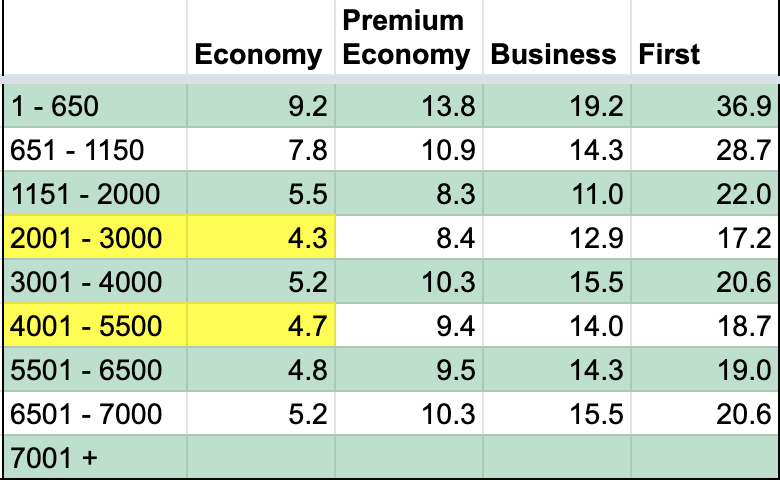
The highlighted ranges are the two used in the Santiago example.
Note that the best case scenario of the range (flying exactly 5,500 miles) is a rating of 4.7, which is better than either of the results in the real example.
Which is all to say, it just depends on the route, and to maximize the value, you need a route as close to 3,000 flown miles as possible.
BA Avios vs Iberia Avios
I also shared a recent post on the 7 Iberia Avios award charts. You can not only redeem your BA Avios on Iberia, but you can transfer your BA Avios to Iberia Avios (they’re owned by the same parent company) and use your Iberia Avios to book the same flights at different rates. Sometimes better, sometimes worse rates, and the fees also differ.
First, let me just compare prices of the BA Multi-Carrier to Iberia’s. The other award charts are similar enough that I’m going to compare them another way.
How much more expensive (red) is the BA OneWorld award chart than Iberia’s?
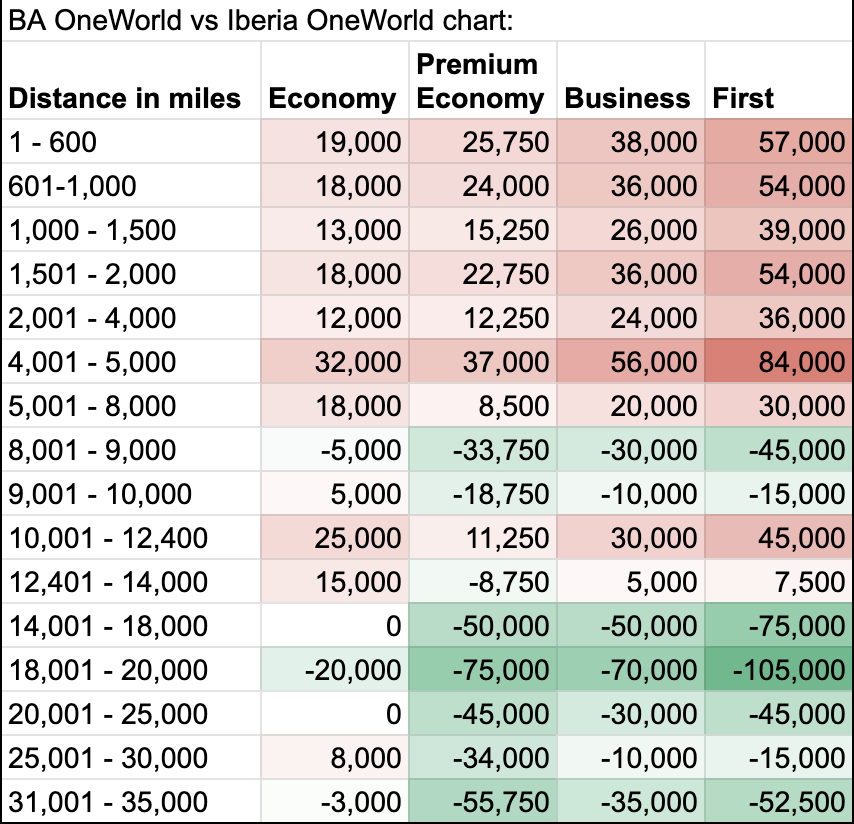
Negative numbers in green represent when it’s cheaper to use BA Avios’ OneWorld chart, and positive numbers in red represent when the Iberia OneWorld chart is cheaper.
As you can see, longer range flights are much cheaper using BA Avios and Iberia Avios has much cheaper OneWorld flights in the shorter ranges.
However, not included are the ranges above 35,000 flown miles that Iberia has. Iberia has two additional ranges that go up to 50,000 miles.
For all the partner flights I made another type of chart. For each chart I showed what the best possible value (efficiency rating), the range, and for the partner section, show which partner chart is used.
Best Efficiency Ratings: BA Avios vs Iberia Avios
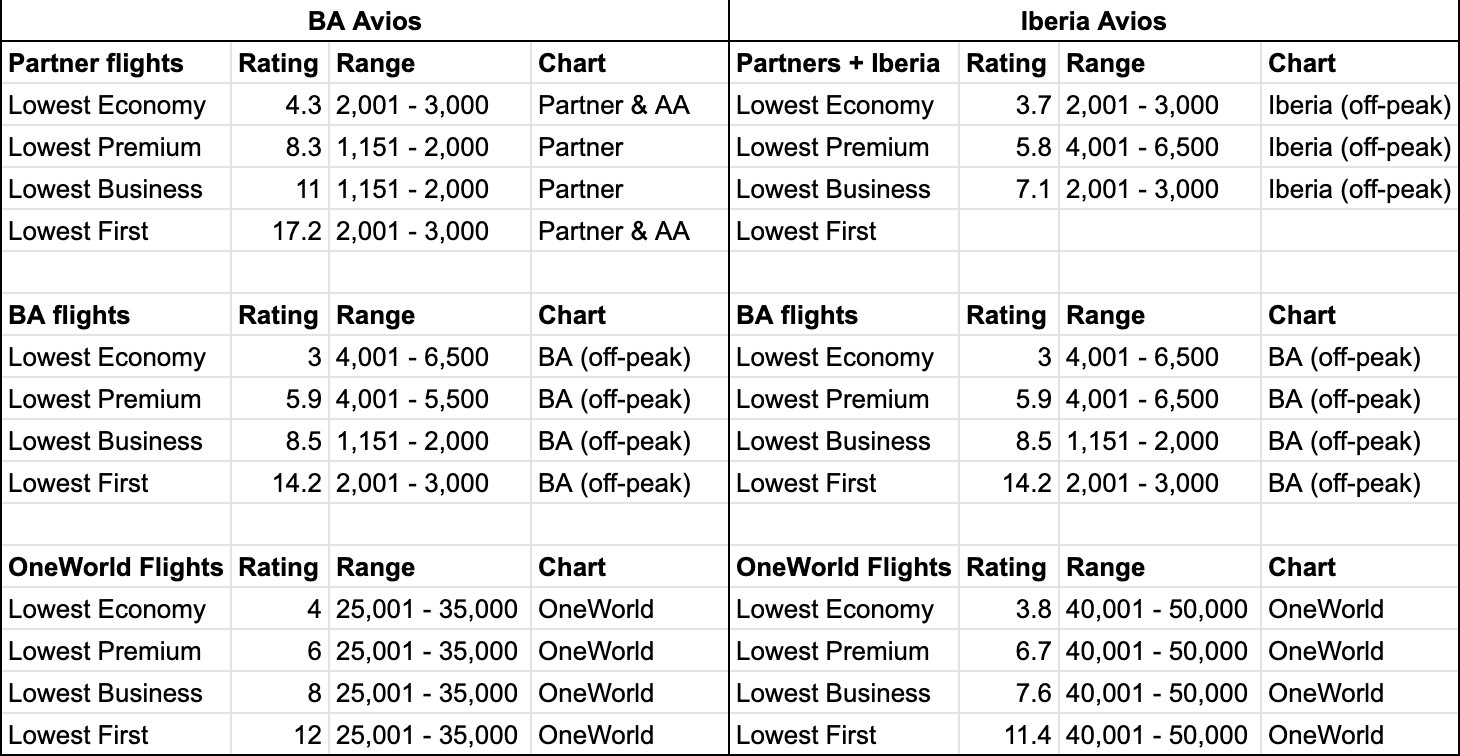
As you can see, there are a few cases where the Iberia price in the award chart has the same values, but the added fuel surcharges are lower on Iberia when using Iberia Avios.
Otherwise, it’s cheaper (and easier) to use BA Avios on Partners or AA.
Finally, in the chart above this one that compares the OneWorld charts between BA and Iberia Avios, we couldn’t compare the top ranges and this allows us to compare the best values.
Despite BA generally having better prices for long haul flights, Iberia Avios has two additional super long ranges above 35,000 flown miles. And while the price is slightly better than BA Avios, it’s unfortunately too long for a realistic trip. Flying 50,000 miles (which is barely the best first class value period) is nearly impossible.
I just checked the miles for a route that would hit all 6 [inhabited] continents and it wasn’t even 40,000 flown miles.
Conclusion
To me, the take away is that the best value is BA Avios partners at 3,000 miles or right under.
Next, Iberia has some decent values, but you’d want to use Iberia Avios to reduce fees.
Again, this was set up with the earlier post on the BA Award Charts. Similarly, this post sets a new version of Saving Avios with Stopovers kind of post. I haven’t done one in a long long time, and I think it’s about time.




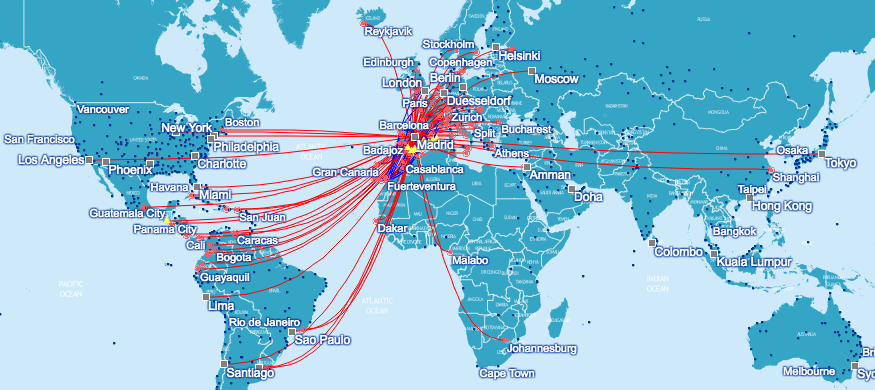
Thought my head was going to explode trying to follow all this.
Sorry bout that. Hope you survived tho!
Which is better a high efficiency rating number or a low number? Thank you for all the hard work you do.
Think of it as cost per mile.
Yeah, basically cost per mile… so lower is better.
[reward] miles per [flown] mile.
Using bogota is great for an example to lower points cost, but they have very high taxes if you book it as two separate awards which would never make that worthwhile unless you wanted to spend time in colombia, which is a good place to spend some time.
Using your metrics, the 20k aa off peak chart 5 years ago for bri-txl-jfk-san-hnl (this included a stopvover too). would be 20,000/9833 or efficiency rating of 2.034. I think thats my best efficiency factor. The taxes/fees could be somehow included in your formula to improve it; also when flying BA last minute in europe is just a flat fee ($27.50).
I like the concept you’ve created.